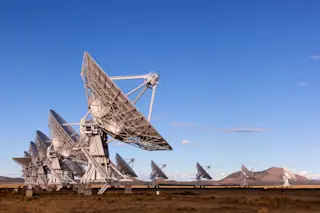Radio telescopes at the Very Large Array, the National Radio Observatory in New Mexico (Credit: Manamana/Shutterstock) A minor fracas between astronomers and robo-lawnmowers has been making headlines, which sounds painfully futuristic. At issue, whether the maker of Roomba can let its autonomous mower operate on restricted radio frequencies that telescopes use to observe the cosmos. And the whole thing is futuristic in another, more subtle way, as well. Robot lawnmowers are just one of the many coming gadgets that will be incorporated into the Internet of Things, a wireless network in which even our everyday appliances will participate. And it’s that future that has astronomers on edge. A Web of Nouns The trouble began because iRobot doesn’t want its customers to have to do any physical labor — not cutting the grass and definitely not digging the trenches for the underground wires that most autonomous lawn mowers use to sense ...
Why Astronomers Will Hate the Internet of Things
The Internet of Things poses challenges for radio astronomy, as devices like lawn mowers compete for precious radio frequencies.
More on Discover
Stay Curious
SubscribeTo The Magazine
Save up to 40% off the cover price when you subscribe to Discover magazine.
Subscribe













